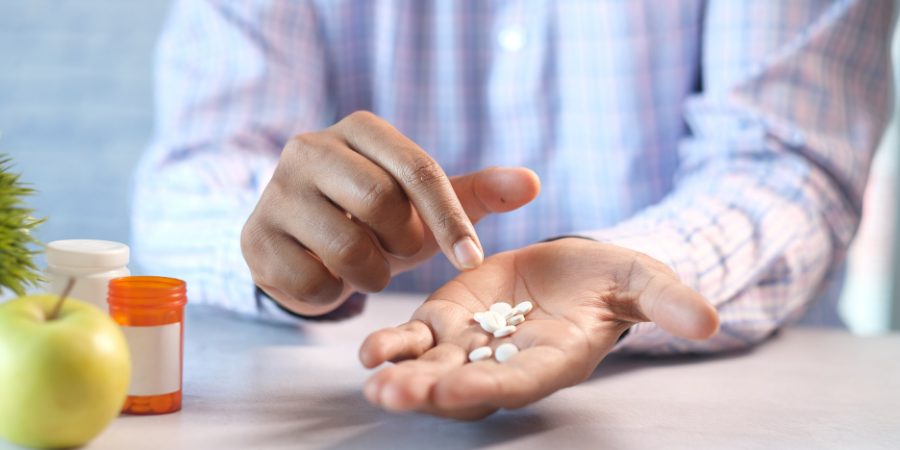
Written by:

Medically Reviewed by:
Last Updated:
March 27th, 2025
OxyContin addiction
OxyContin, a brand name for the medication oxycodone, is a pharmaceutical drug that is part of the opioid family. While widely prescribed to treat moderate to severe pain, OxyContin addiction can develop under the radar, with many users not realising addiction has crept in before it becomes a family issue. In 2016, 330,445 people in the UK were reported to be high-risk opioid users. This number has inclined over the years, as medication becomes more widely accessible.
Read on to discover the health risks of OxyContin addiction, the signs and symptoms to look out for, and how the condition can be approached.

What is OxyContin?
OxyContin is a semi-synthetic opioid derived from a part of the opium poppy. Oxycodone was first synthesised in 1917 by German scientists with the hopes of improving the effectiveness of opioid painkillers. Scientifically it is a unique drug, 50% more potent than morphine.
Although OxyContin is a potent drug, if you carefully follow the doctors’ instructions and prescription, there should be no long-term problems associated with its use. Trouble ensues when OxyContin is used outside of these medical boundaries.
How OxyContin addiction develops
OxyContin blocks pain signals by binding to and activating opioid receptors in your brain, resulting in your brain’s attempt to accommodate the influence. Once OxyContin reaches your brain, it encourages the production of endorphins. Endorphins transmit signals throughout your brain and spinal cord in response to stimuli.
These endorphins block pain signals and create feelings of pleasure. Dopamine is a neurotransmitter responsible for creating feelings of pleasure, which is a key to understanding the addictive properties of OxyContin. In short, the natural human tendency to repeat pleasurable experiences is induced by OxyContin, triggering the production and release of dopamine.
Physical dependence can occur with OxyContin abuse or with long-term OxyContin use, even when the drug is taken as prescribed. OxyContin dependence means you feel you need it to operate normally.
OxyContin abuse
OxyContin abuse and addiction are on the rise in many parts of the western world, particularly the US and the UK, where access to OxyContin is easily available. People fall into the trap of oxycodone abuse via two main tributaries, either developing a reliance on their prescription or acquiring the drug illegally for recreational use. Unfortunately, both of these methods present the same risk factors, as they can lead to OxyContin addiction and dependence.
Are you addicted to OxyContin?
Warning symptoms of OxyContin addiction
In general, people don’t treat prescription drugs as hostile as illicit drugs, as they perceive them to be safe. This is a common trap and should be avoided. Pharmaceutical drugs are as addictive and dangerous as other illicit drugs. This leaves many in the grips of addiction before they can realise it.
Some common signs associated with OxyContin addiction include drowsiness, sleepiness and muscle weakness.
Physical warning signs
- Sustained lethargy
- Regularly constricted pupils
- Unexplained weight loss
- Bouts of slurred speech
- Episodes of severely itchy skin
- Episodes of vomiting
- Frequent blackouts
Social warning signs
- A lack of interest in personal appearance
- A lack of interest in previously enjoyed hobbies
- Gradual isolation from both family and friends
- More frequent mood swings
- Episodes of depression and anxiety
- Reduced performance at school or work
Behavioural warning signs
- A willingness to doctor-shop for OxyContin prescriptions
- Defensiveness over one’s use of the drug
- Attempts to purchase OxyContin on the street or online
- A willingness to steal
- Leaving old friends behind in exchange for new friends who also use
- Frequent episodes of erratic behaviour
If you believe that you cannot function without your medication and are going to desperate lengths to get your hands on it, you are likely addicted to OxyContin. A sign of physical dependence on OxyContin is the presence of withdrawal symptoms whenever you try to quit or cut down on your use. If taking your medication alleviates these symptoms, you are caught in a cycle of OxyContin abuse.
OxyContin overdose
The most dangerous health risk of OxyContin addiction is overdose, as it can be fatal if not addressed quickly enough. Shockingly, OxyContin overdose puts you at risk of hypoxia, which is a condition that starves your brain of oxygen. This results in short or long-term brain damage, and in severe cases, you can lapse into a hypoxia-induced coma. OxyContin overdose also places your heart at risk of cardiac arrest because it reduces your heart rate to a dangerously low level.
Signs of OxyContin overdose
- Significant breathing problems
- Low blood pressure
- Reduced heart rate
- Severely constricted pupils
- A bluish tint to lips and fingernails
- Cold sweats
- Muscle weakness and loss of motor function
- Extreme fatigue and sleepiness
- Loss of consciousness and/or coma
To avoid an OxyContin overdose, refrain from mixing the drug with other sedatives such as alcohol and other drugs and stick to your prescribed dosage, only consuming it when you need to.
DID YOU KNOW?…
- OxyContin street names include: 40; 80; blue; hillbilly heroin; kicker
- Nearly 1 million deaths a year are blamed on oxycodone addiction.
- 25% of 16 to 59-year-olds who misused prescription painkillers reported having taken another drug in the last year.
- The global opioid consumption rate declined by 30% from 2009 to 2019.
- Per capita, Britain consumes the most opioids in the world.
How to overcome OxyContin addiction
With the help of a solid support system, whether that is family and friends, or a fellowship support group, you can overcome OxyContin addiction. By seeking professional medical help, you are giving yourself the best opportunity to overcome addiction.
It is essential to acknowledge quitting is the first step to making a full recovery. UKAT offers professional and proven methods of recovery. Read on to the OxyContin detox and OxyContin rehab pages to find out more about the recovery process.





